
Creating Deep Space Nine - By Herman Zimmerman, Rick Sternbach,
and Mike Okuda.
While Rick Berman and Micheal Piller were developing all the characters for Star Trek: Deep Space Nine,
Herman Zimmerman, Rick Sternbach, and Mike Okuda were given the task of designing the station itself.
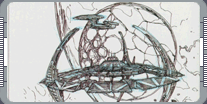 Production designer Herman Zimmerman and his team were given three months to create the new space station -
which is an unusually generous amount of time. "Most shows give you a couple of weeks or maybe a month at
best," says Zimmerman. "This was an enormous gift in terms of creative noodling, and I think it paid off in
terms of the final product. We had a chance to try things that didn't work and try thing that eventually did
work, and pick and choose as to what we thought about how to begin the series. I think the two hour pilot
was well thought out by Piller and Berman, and I think brilliantly directed by David Carson. I think the
tone of the whole seven year episodic adventure was established in that two hours, and we remained true to
it, we elaborated on it, we made it an in-depth experience for the viewers and all of us who worked on it.
We've all been enriched by the fact that we've been able to be a part of this."
Production designer Herman Zimmerman and his team were given three months to create the new space station -
which is an unusually generous amount of time. "Most shows give you a couple of weeks or maybe a month at
best," says Zimmerman. "This was an enormous gift in terms of creative noodling, and I think it paid off in
terms of the final product. We had a chance to try things that didn't work and try thing that eventually did
work, and pick and choose as to what we thought about how to begin the series. I think the two hour pilot
was well thought out by Piller and Berman, and I think brilliantly directed by David Carson. I think the
tone of the whole seven year episodic adventure was established in that two hours, and we remained true to
it, we elaborated on it, we made it an in-depth experience for the viewers and all of us who worked on it.
We've all been enriched by the fact that we've been able to be a part of this."
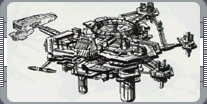 Early discussions about the look of the station led to a concept that eventually didn't work out. "It took
us a couple months of going in the wrong direction to find the right direction," Zimmerman says, "partly
because the producers weren't sure exactly how they wanted to direct us with the visual elements. We started
out charged with getting a 'Tower of Babel' concept of a space station built over a couple thousand years of
separate, disparate cultures, so the technology from one part of the station to another would be of various
ages and various cultures, not neccessarily interfacing one with the other, and there was this sense of
confusion because of that."
Early discussions about the look of the station led to a concept that eventually didn't work out. "It took
us a couple months of going in the wrong direction to find the right direction," Zimmerman says, "partly
because the producers weren't sure exactly how they wanted to direct us with the visual elements. We started
out charged with getting a 'Tower of Babel' concept of a space station built over a couple thousand years of
separate, disparate cultures, so the technology from one part of the station to another would be of various
ages and various cultures, not neccessarily interfacing one with the other, and there was this sense of
confusion because of that."
Rick Sternbach takes up the story. "The initial take on it was that it was a very old, ancient type of
station - maybe not symmetrical in shape. Perhaps it was built in a sort of hodge-podge nature. It could be
that it was an ancient Bajoran structure from thousands of years ago. As Berman and Piller continued to
refine the concept of DS9, we continued to evolve some of the exterior station drawings. We started
with a very large number of sketches and very quick CGI shapes that we could build in our computers. We had
some 3D modeling software on the Mac. We could create a lot of shapes, make multiple copies of shapes and
kind of put little pieces together and rotate them around and see how they would look. Also we could see if
they would provide enough of a strange alien look that would be approved as DS-9."
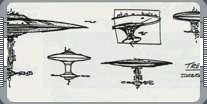 Mike Okuda adds that this freewheeling approach to the station led to some very unusual designs. "I did a
whole bunch of really weird different things. But the one that went the furthest was a version that had
actually started out inspired by an airport terminal. Then it became much more complicated and started
looking like an oil derrick. Herman, Rick, and I liked it a lot and Berman and Piller liked. Sternbach went
to the point of actually building a very detailed study model of it." As Okuda explains, even at this early
stage the team had an idea of what the stations's interiors would look like, and this had an influence on the
outside. "The terracing effect on several of the drawings was done to match windows that Herman was
designing for the full-scale sets. This way there'd be hundreds, even thousands, of copies of that set
through the station and we could credibly reuse the basic set over and over again."
Mike Okuda adds that this freewheeling approach to the station led to some very unusual designs. "I did a
whole bunch of really weird different things. But the one that went the furthest was a version that had
actually started out inspired by an airport terminal. Then it became much more complicated and started
looking like an oil derrick. Herman, Rick, and I liked it a lot and Berman and Piller liked. Sternbach went
to the point of actually building a very detailed study model of it." As Okuda explains, even at this early
stage the team had an idea of what the stations's interiors would look like, and this had an influence on the
outside. "The terracing effect on several of the drawings was done to match windows that Herman was
designing for the full-scale sets. This way there'd be hundreds, even thousands, of copies of that set
through the station and we could credibly reuse the basic set over and over again."
 Although everyone was interested in the oil derrick concept, Zimmerman says that it didn't seem quite right.
"We did literally reams of drawings and computer simulations and even models of space stations. None of them
seemed to be appealing. None of them were, in the last analysis, slick enough or alien enough or unusual
enough to satisfy Rick Berman's desire for a show that would not compete with Star Trek: The Next Generation
and would not be derivative of any existing features or of the original series." Berman rejected the
original approach to the station and sent Zimmerman and his team back to look for new directions. Sternbach
adds though not all the work that had been done was wasted. "We had a number of key elements that were
retained from the very beginning of the design process. Even the oil rig platform had something of the
central core. Because we knew that we had to have an op module or tower of some sort. We knew that we had
to have a promenande. I sort of assumed that we would have something of a central power generating facility,
and all of these central elements began to stack one on top of the other. The only thing we didn't know was
what was going around the outside of it."
Although everyone was interested in the oil derrick concept, Zimmerman says that it didn't seem quite right.
"We did literally reams of drawings and computer simulations and even models of space stations. None of them
seemed to be appealing. None of them were, in the last analysis, slick enough or alien enough or unusual
enough to satisfy Rick Berman's desire for a show that would not compete with Star Trek: The Next Generation
and would not be derivative of any existing features or of the original series." Berman rejected the
original approach to the station and sent Zimmerman and his team back to look for new directions. Sternbach
adds though not all the work that had been done was wasted. "We had a number of key elements that were
retained from the very beginning of the design process. Even the oil rig platform had something of the
central core. Because we knew that we had to have an op module or tower of some sort. We knew that we had
to have a promenande. I sort of assumed that we would have something of a central power generating facility,
and all of these central elements began to stack one on top of the other. The only thing we didn't know was
what was going around the outside of it."
Zimmerman explains that the new brief allowed him and his staff to explore avenues that had been rejected at
an earlier stage. "When we finally arrived at the concept have now, it was because Berman said, 'OK, forget
about the Tower of Babel, forget about the various cultures; give me the most alien thing that you can create
that could be a space station at the edge of the Galaxy.' I think we succeeded in doing that. One of the
things he said he wanted was, 'No matter where you are, if you can see your television set at all, from the
corner of the kitchen, from a chair in the living room, looking up from your homework in bed, when you see
that image on the screen you know immediately it is Deep Space Nine and nothing else.' That actually was a
pretty tall order, to design something that is immediately recognizable for what it is and couldn't be
anything else."
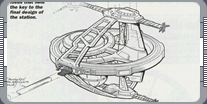 Rick Sternbach remembders that this desire for a simple shape, led the team back to one particular concept.
"We went back to something that Herman had offered up initially, which was a series of nested sort of hoop
structures, or ring structures, and went back to that concept of a round wheel type of station."
Rick Sternbach remembders that this desire for a simple shape, led the team back to one particular concept.
"We went back to something that Herman had offered up initially, which was a series of nested sort of hoop
structures, or ring structures, and went back to that concept of a round wheel type of station."
This new direction incorporated three separate ideas. "I thought of a gyroscope shape as maybe being a basic
form that we could work with. We also vaguely connected the gyroscope shape with the shape of atom, with all
the electrons running around the nucleus. So what you see in the Deep Space Nine exterior now is a
combination of the nucleus of an atom, a Mercedes emblem, and a gyroscope. The Mercedes emblem is quite
important design-wise because we decided that Cardassians like things in threes. So we have three concentric
rings - they're not on the same level, they they're joined by three arms that join three rings together - and
then we have three weapon towers/docking rings that are off of the final ring, the cargo ring. Originally
all those rings were connected as they would be if you were making a nucleus or a gyroscope, and that didn't
look right, so we cut the tops and bottoms off and in doing so we found places to dock ships and we found a
shape that was very pleasing to the eye."
Establishing a Cardassian design style was far from easy. At that point only one Cardassian ship had been
design, and the team didn't have much to go on. Zimmerman says DS9's other concept artist made the
breakthrough.
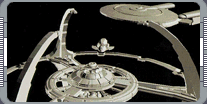 "Ricardo Delgado came up with some wonderful surface ornament that was based on Bob Blackman's costumes for
the Cardassians, and loosely based in addition on Michael Westmore's makeup for them, both of which had been
seen in TNG. But Cardassia was kind of of an unknown, and we made it up as we went along. Wes evolved the
language of what the Cardassian like and dislike by extrapolation from those makeup and costume hints, and I
think we ended up created something quite unusual."
"Ricardo Delgado came up with some wonderful surface ornament that was based on Bob Blackman's costumes for
the Cardassians, and loosely based in addition on Michael Westmore's makeup for them, both of which had been
seen in TNG. But Cardassia was kind of of an unknown, and we made it up as we went along. Wes evolved the
language of what the Cardassian like and dislike by extrapolation from those makeup and costume hints, and I
think we ended up created something quite unusual."
Now Zimmerman and the production team had to get the station built on time. "There was some haste neccessary
because we had used up two of our three months of preproduction going in the wrong direction, so when we got
the right direction we had precious little time left to make it all work. We got an incredibly beautiful
model made by Brazil Fabrication in Glendale - Tony Meininger's company. He is a really skillful
modelmaker."
Sternbach adds that by now most of the details had been worked out pretty much accurately and the
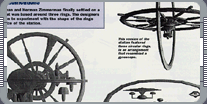 design only changed very subtly. "When the blueprints were delivered, there were very few changes. All the
major story point pieces on the station had been detailed out and approved and built into the station.
Tony's shop created some enlarged sections, especially of the runabout hanger so that we could see in the
opening episode the hanger door opening and the runabout rising to the surface. We could see closeups on
some of the surface. Once that six-foot miniature was constructed and photographed, it remained the focal
point of the series for the next seven years." Zimmerman adds, "This six-foot diameter model of the Deep
Space Nine station is what you see on the air every week, and it is exquisite. It's the best model I've ever
seen."
design only changed very subtly. "When the blueprints were delivered, there were very few changes. All the
major story point pieces on the station had been detailed out and approved and built into the station.
Tony's shop created some enlarged sections, especially of the runabout hanger so that we could see in the
opening episode the hanger door opening and the runabout rising to the surface. We could see closeups on
some of the surface. Once that six-foot miniature was constructed and photographed, it remained the focal
point of the series for the next seven years." Zimmerman adds, "This six-foot diameter model of the Deep
Space Nine station is what you see on the air every week, and it is exquisite. It's the best model I've ever
seen."
Zimmerman's Cardassian look is pretty much in tune with the atmosphere of the race's architecture, seen in
TNG, although he didn't really become aware of that image until after the DS9 station was designed. A case
of great minds think alike, it seems. "Well, we have a family of people that have been together for a long
time," Zimmerman says, "first on TNG and DS9, and then Voyager - not every on of us have worked on all three,
but some of us have - and we have Rick Berman's guidance."
|
|
"CREATING STAR TREK: DEEP SPACE NINE (PART 3)" - OCTOBER 1999 ISSUE 6 STAR TREK: THE MAGAZINE COPYRIGHT OF
PARAMOUNT PICTURES.
|